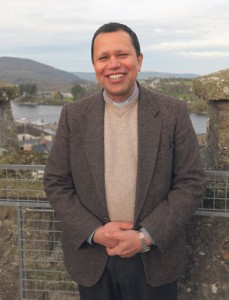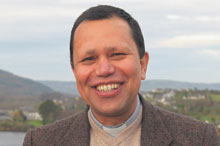When Very Rev Gary Paulsen came to visit Rev Canon Bob Hanna in Ennis a few years ago and asked for directions to the Anglican Church, no one he spoke to knew what he was talking about. His request to locate the local Church of Ireland was also greeted with silence.

Rev Paulsen drove on to a petrol station and repeated his request, where a man asked him “do you mean the Protestant church?”
While the Rector of Adare eventually found Rev Hanna, he was amazed by the lack of local knowledge about different faiths and religions.
His home town of Athlone in the Western Cape, near Cape Town, is an eclectic mix of Portugese, English, French, German, Malaysian and other cultures, which fostered a large variety of religions. There is no dominant church, everyone lives side-by-side and religious leaders meet each other on a regular basis.
Rev Paulsen said he dislikes the Protestant label, as he doesn’t see himself as “protesting against anything”, including the Catholic Church. He says he always saw the Church as one entity – Anglo Catholic and Roman Catholic. There are different churches belonging to the Anglican Communion and he comes from the Church of Southern Africa.
The new Dean of Killaloe Cathedral has received a warm welcome from locals in Ballina and Killaloe since his inauguration, on the same day former South African president and ANC leader, Nelson Mandela was buried.
He says he wants to spend his first six months listening to locals before embarking on a new “journey with the community”.
Over 20 cards are displayed on the mantlepiece of the sitting room in the deanery, situated across the road from Convent Hill Shopping Centre.
The former Rector of Adare fills the vacancy left by Stephen White, who took up a theology position in London over a year ago. As the new Dean, he will be responsible for the cathedral and running three parishes in Castleconnell, Mountshannon and Killaloe Cathedral. He will be a member of the senior clergy team in the diocese.
Bishop of Limerick and Killaloe, Trevor Williams, said Rev Paulsen has already made a significant contribution to the diocese.
“He is a fantastic parish priest and a man of great vision and energy. He is very committed to working with the community. His wisdom, creativity, energy and insight will bring a lot to diocese,” he said.
Bishop Williams believes there is huge potential to develop Killaloe Cathedral for the benefit of the community and tourists, as well as a spiritual resource for the diocese.
Ordained in St George’s Cathedral, Cape Town in 2003, Rev Paulsen was a late vocation to the Anglican Church. His last parish before he came to the Ireland four years ago was in the winelands of South Africa.
Saldanha Bay and Limerick had a link for five years and he was on the committee that facilitated visits from the Archbishop of Limerick and Archdeacon to South Africa in 2010.
The Archbishop of Limerick told him about the vacancy in Adare, which sowed the seeds of making a life-changing move. After three years in Adare, the 54-year-old single father-of-two moved to the Deanery in Killaloe last December.
As a young man he qualified as a quantity surveyor and became a project manager at the age of 28, which was considered young for such a demanding job. He worked for a major construction civil engineering and building company. One major development that he oversaw in Cape Town, costing between 30 to 40 million rand, included 158 houses, a hospital, a healthcare centre, road works and some civil works.
However, he was always involved in the church at some level. In his twenties, he recalls talking to his local parish priest about experiencing a sense of calling to the ministry.
“The parish priest advised me to give it some time. Then you get involved in life, you get a promotion and you are doing well. People thought I was crazy to give up what I had achieved.
“From my younger days, I was involved in youth ministry. I also had a lay ministry role in the church. One day I spoke to the priest and said I want to do this full time. He told me this would mean giving up what I had and going to a seminary.
“It was a hard decision to make because I gave up a comfortable life. Having already completed the necessary theological studies meant I had to get used to living in a seminary with morning prayer, evening prayer as well as receiving the Eucharist every day,” he said.
Entering his late thirties, he was much older than most of the new seminarians, who were 18, 19 or in their early twenties. He found he could relate more to the lecturers and teachers. He was also given additional responsibilities, which he found helpful during the transition period.
He says having lived in the ‘real world’, he found it a big advantage when it came to ministering in his first parish. He knew what it was like to have an affluent lifestyle, socialising in the pub and enjoying parties, which helped him to relate to well-off sections of society.
His work as a project manager he found proved helpful in dealing with the task of managing finances and putting a management structure in place in a parish.
His salary, though, declined dramatically from 8,000 to 800 Rand a month. “One of the hardest things for me was accepting charity or money from parishioners; if someone gave me 50 Rand, that was quite tough,” he said. There were times when he wondered about his decision but always came back to the sense that this is what God wants for him.
Before his sister died from cancer, she asked him to raise her three children. She felt her husband, who has since remarried, would struggle rearing three children as a single father. Rev Paulsen divorced in his thirties and while he can’t definitively cite the exact reason, his dramatic career change may have been a factor. He had to raise five children, with the help of his mother.
His son, Simeon (19), who also lives with him in Killaloe, is studying Business and Accounting in Limerick Institute of Technology and both of them are avid Chelsea supporters. His daughter, Cassie, works for a shipping company in America. She returns to Killaloe next month.
He sees his role as a co-ordinator in Killaloe as empowering a community and is not keen on providing all the answers or carrying out all the work. Describing his journey to ministry as “enriching”, he believes the most important message is how do people in an ordinary way find God.
Coming from South Africa, which was divided by race and political conflict, he hates when people place a religious label on each other, using divisive terms like Protestant and Catholic.
“How do we meet each other in our own humanity? You might be Protestant or Catholic, but Jesus was a Jew, neither Protestant or Catholic. People have politicised their church.
“When Mother Theresa picked up someone from the street, she didn’t ask them about their religion.
“People find God in different ways, on the River Shannon, walking in the fields or digging in the garden and painting,” he said.
He derived great satisfaction from the recent ecumenical Christmas Carol service in Mountshannon, which had great input from local national school children, teachers and Fr John Jones.
He believes it is great to see the entire community coming together, regardless of their own particular faith.
When people say they are not of his “persuasion”, he assures them this doesn’t matter. However, he believes religion should be taken out of all Irish schools and handed to the State.
While Killaloe Cathedral is primarily a place of worship, he acknowledges it is an ideal focal point for exhibitions, concerts and appropriate events during the Brian Boru celebrations in the locality marking the 1,000th anniversary of his death. He appreciates that people view the iconic structure as “our cathedral”, regardless of their religion.
Growing up as ‘Cape coloured’
THE bitter division caused by racial segregation in South Africa over a 46-year period started from the cradle and ended in the grave for thousands of people.
Gary Paulsen was in national school during the controversial Apartheid regime when black people couldn’t mix, or even communicate, with white people.
Under the hated system enforced through legislation the by National Party (NP), the ruling party from 1948 to 1994, newborn babies were graded in terms of their colour following examination.
Rev Paulsen was graded as “Cape coloured” on his identity card, a higher classification than black people, which allowed him to get a proper education and facilitated his rise to become a quantity surveyor.
He recalled that people couldn’t really categorise their family because they were all so different. His father, George had blue eyes and fair skin and was classified as white, while his mother, Roberta, was regarded as brown, leaving their son “somewhere in the middle”. His sister, who died from cancer when she was 36, had light blonde hair and fair skin.
Churches didn’t escape division with a brown, black and white gathering, depending on skin colour. In the Western Cape, where Rev Paulsen grew up, there were not many black people but mostly Indian and European. There were two doors at the local post office and shop for ‘White’ and ‘Non White’, while white people sat downstairs on double decker buses where black people could only sit on top. Schools were segregated and blacks never got an education.
“Black and brown people were the maids and the road sweepers and labourers, who did the menial work. Black people were made to feel unworthy.
“People who were involved in mixed relationships were jailed, as this was in conflict with the Immorality Act. My mother couldn’t go funerals of her cousins.
“At schools, we protested against Apartheid. We were chased and whipped by the police. We were shot with tear gas. It was really the school children that started the protest.
“Thousands of black South Africans disappeared. They don’t know the exact numbers, but they estimate it could be millions. Thousands of people were put into airplanes and taken out to sea where they were just dumped.
“People were poisoned. Activists received letter bombs. People could be jailed for life without a trial,” he said.
He recalled the Anglican Church, led by Archbishop Desmond Tutu, played a pivotal role in the establishment and running of the Truth and Reconciliation Commission, which started the painful healing process between the two ethnic communities.
“It was difficult sitting opposite people that killed your children.
“That was the life I grew up in. When I come to Ireland and someone says ‘you are Protestant’, my ears prick up. I have enough labels in my life. I want people to experience me as a human being, for what I am,” he added.
When black people stood up and protested about Apartheid, he recalled they were branded terrorists.
When Nelson Mandela was moved to Victor Verster prison near Paarl, he was held in a house formerly occupied by a warder. Rev Paulsen visited this house a number of times where negotiations between the ANC and the government were held, before Mandela was finally released. He was given the freedom of this house with a security guard and a cook for the last few years of his jail sentence.
Rev Paulsen explained it was easier for people to visit Mandela in his house unnoticed.
“The South Africa government were prepared to release Mandela earlier but he refused to leave the house until Apartheid was gone. Mandela told them this is something I have spent all my life on and it is something I am prepared to die for.
“The government also had to protect Mandela from the extreme right faction, who wanted to kill him and keep Apartheid going. He was under armed guard for his own safety,” he explained. This house has now been turned into a tourist centre.
East Clare correspondent, Dan Danaher is a journalism graduate of Rathmines and UL. He has won numerous awards for special investigations on health, justice, environment, and reports on news, agriculture, disability, mental health and community.


